Recent Water Damage Posts
What To Do When You Have Water Damage
5/6/2024 (Permalink)
Water damage can wreak havoc on your home or property. Water damage can occur from burst pipes, leaking roofs, storms, floods, and hurricanes. The consequences can be devastating, leading to structural damage, mold growth, and potential health hazards.
When facing these situations, it is best to contact a restoration company such as SERVPRO®. However, here are some simple actions you can take while you wait on a SERVPRO team to arrive at your home.
Turn off the Power
Attempt to safely switch off the electricity and gas to avoid electrocution and gas leaks. If unable to do so due to an extensive amount of water in the home, wait for a SERVPRO team to arrive and cut the power off.
Locate and Stop the Water Source
Identify where the water is coming from. If it is coming from a burst pipe or leaking appliance, turn off the water supply to prevent further flooding.
If the source of the water is external, such as a storm or flooding, do your best to divert or contain the water from further damaging your home and furniture.
Remove Excess Water
Use pumps, wet/dry vacuums, buckets, or towels to remove as much water as possible from the affected area. The faster you can extract the water, the better chance you have of preventing further damage and mold growth.
Move Belongings Out of Water
To prevent further damage to your furniture, move them to another room that is dry. If you have heavy furniture that you are unable to lift and move around, wait for a SERVPRO team to arrive to assist with moving the furniture.
SERVPRO also specializes in restoring any piece of furniture that has been damaged during the disaster.
Call your Insurance Company
Once you have done all the above, now is the time to contact your insurance company and investigate what is covered in terms of water damage. Document the damage thoroughly and file a claim with your insurance as soon as possible in order for you to get reimbursed for the costs of mitigation.
Dealing with water damage is a long and stressful process. Luckily, SERVPRO is available 24/7 with a team of certified professionals who are equipped with advanced equipment to resolve disasters like these.
SERVPRO, the only restoration company that makes “Like it never even happened” happen.
Hygrometers: The Unsung Heroes of Water Damage Restoration
5/30/2023 (Permalink)
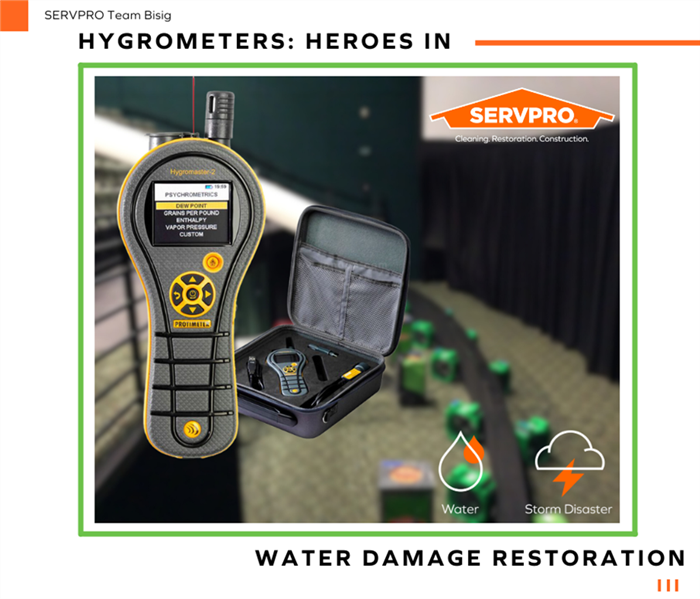 Our SERVPRO restoration technicians use hygrometers like this Protimeter Hygromaster 2 when restoring water damage here in Cherokee County, GA.
Our SERVPRO restoration technicians use hygrometers like this Protimeter Hygromaster 2 when restoring water damage here in Cherokee County, GA.
Understanding Hygrometers
Hygrometers are indispensable tools in the world of water damage restoration, yet many people are unfamiliar with how they work. A hygrometer is an instrument designed to measure the amount of moisture, or humidity, in the air. This invaluable tool can help prevent mold formation and other issues related to excess moisture, making it a key component of the water damage restoration process.
The Mechanism Behind Hygrometers
A hygrometer works by detecting changes that are dependent on the level of moisture in the atmosphere. There are different types of hygrometers - mechanical, electrical, and wet and dry bulb - and each has its own mechanism for gauging humidity.
Mechanical hygrometers, for instance, function by using organic materials such as hair or animal gut which expand and contract in response to humidity changes. These movements are then converted into humidity readings.
On the other hand, electrical hygrometers utilize humidity-sensitive capacitors. The humidity in the air changes the capacitance in these components, and these alterations are converted into humidity readings.
The wet and dry bulb hygrometers, also known as psychrometers, employ two thermometers: one dry, the other covered with a wet cloth. Evaporation from the wet cloth cools the thermometer, and the temperature difference between the two bulbs can be used to determine the humidity.
Hygrometers in Water Damage Restoration
In water damage restoration, professional technicians use hygrometers to measure humidity levels and monitor the drying process in water-damaged spaces. By accurately assessing the humidity levels, SERVPRO of Cherokee County can ensure that the area is thoroughly dried and reached what we call the “Dry Standard”. This is a target moisture level that reduces the risk of mold growth and structural damage from environmental conditions. This is a critical part of our comprehensive water damage repair and restoration services.
Hygrometers: A Tool for Prevention and Mitigation
While hygrometers are crucial in water damage restoration, they're also handy devices for homeowners. Regularly monitoring humidity levels can help maintain a healthy indoor environment and alert homeowners and property owners to potential moisture issues. By catching these issues early, property owners can call in the professionals for water damage prevention measures, potentially saving thousands of dollars in repairs.
Ensuring the Best in Water Damage Restoration
At SERVPRO of Cherokee County, we understand the significance of a thorough water damage restoration process. Armed with tools like the hygrometer, we ensure your property is properly dried and restored, mitigating any further damage or issues like mold growth.
If you're facing a water damage situation or want a consultation for prevention strategies, reach out to us today. We bring our expertise and advanced tools, including the humble yet powerful hygrometer, to every job, guaranteeing top-quality water damage restoration for all our clients. Call us at (770) 924-3848 or visit our website to get started.
How to Detect and Fix Leaky Faucets and Toilets: SERVPRO of Cherokee County
4/24/2023 (Permalink)
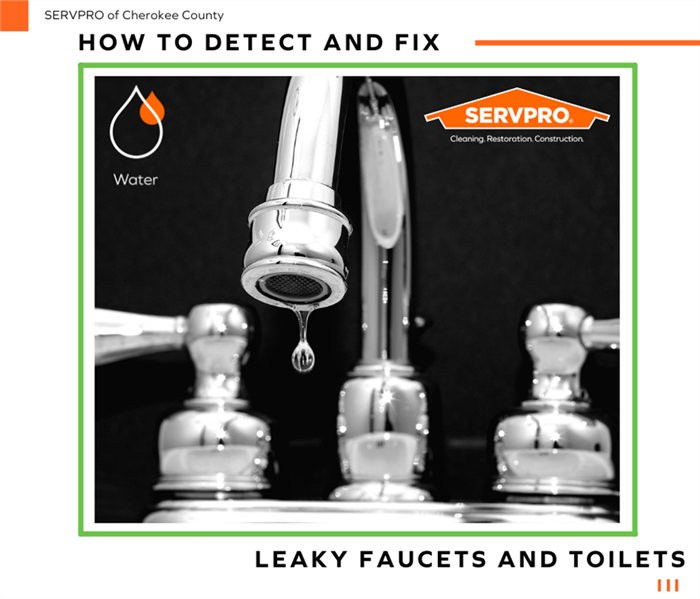 Whether you live in Holly Springs, Canton, Woodstock, or anywhere in between, our local SERVPRO team is here to help 24/7/365.
Whether you live in Holly Springs, Canton, Woodstock, or anywhere in between, our local SERVPRO team is here to help 24/7/365.
Leaky faucets and toilets can cause a range of problems, from increased water bills to water damage in your home. It is essential to detect and fix these issues as soon as possible to prevent the need for costly water damage restoration, mold remediation, and structural repairs. In this guide, we will discuss how to detect leaks and provide step-by-step instructions on fixing them, ultimately saving you time, money, and stress.
Detecting Leaky Faucets and Toilets
- Visual Inspection: The first step in detecting leaks is to conduct a visual inspection of your faucets and toilets. Look for signs of water pooling around the fixtures, dripping water, or damp areas near the pipes.
- Water Meter Check: Turn off all water-using appliances and fixtures in your home, then check the water meter. If the meter is still running, it may indicate a leak in your plumbing system.
- Food Coloring Test: To detect a leaky toilet, add a few drops of food coloring to the toilet tank and wait for about 30 minutes. If the color appears in the bowl, it's a clear indication of a leak.
Fixing Leaky Faucets
- Turn off the Water Supply: Before attempting any repairs, always turn off the water supply to the faucet. This will prevent water damage and ensure a safe working environment.
- Disassemble the Faucet: Remove the faucet handle and any decorative parts to access the inner components. Depending on the type of faucet, you may need to remove a cartridge, a ball, or a compression valve.
- Replace Damaged Parts: Inspect the internal components for signs of wear or damage. Replace any damaged parts, such as O-rings, seals, or washers. In some cases, you may need to replace the entire faucet assembly.
- Reassemble and Test: Reassemble the faucet and turn the water supply back on. Test the faucet for any leaks and ensure it is functioning correctly.
Fixing Leaky Toilets
- Identify the Cause: Leaky toilets can be caused by a variety of issues, such as a damaged flapper, a faulty fill valve, or a cracked overflow tube. Identify the cause of the leak to determine the best course of action.
- Replace the Flapper: If the flapper is damaged or worn, remove it from the flush valve and replace it with a new one. Make sure the new flapper creates a tight seal to prevent water from leaking into the bowl.
- Adjust or Replace the Fill Valve: If the fill valve is the cause of the leak, try adjusting the float level to ensure the water doesn't rise above the overflow tube. If this doesn't resolve the issue, consider replacing the entire fill valve.
- Repair or Replace the Overflow Tube: If the overflow tube is cracked or damaged, you may need to repair it using epoxy or replace it entirely.
Preventing Future Leaks
To prevent the need for water damage restoration or other costly repairs, it's essential to maintain your plumbing system regularly. Here are some tips to help you prevent future leaks:
- Regular Inspections: Conduct regular visual inspections of your faucets and toilets to identify any potential issues early on.
- Routine Maintenance: Replace worn or damaged parts as needed and consider upgrading older fixtures to more efficient models.
- Water Pressure Check: Excessive water pressure can cause leaks and damage to your plumbing system. Install a pressure regulator to ensure the water pressure remains within a safe range.
Detecting and fixing leaky faucets and toilets is crucial for maintaining a healthy and safe home environment. By following these steps, you can prevent water damage, save on water bills, and avoid the need for extensive repairs in the future. However, if you are faced with water damage or need professional assistance with any aspect of water damage restoration, don't hesitate to contact SERVPRO of Cherokee County. Our expert team is trained and equipped to handle water extraction, flood cleanup, dehumidification, mold remediation, structural drying, water damage repair, and disaster recovery. Give us a call at (770) 924-3848 to learn more about our services or to schedule an appointment. Let SERVPRO of Cherokee County help you make it "Like it never even happened."
Smart Home Technology: Using Automation To Protect Your Home From Water Damage While On Vacation
4/21/2023 (Permalink)
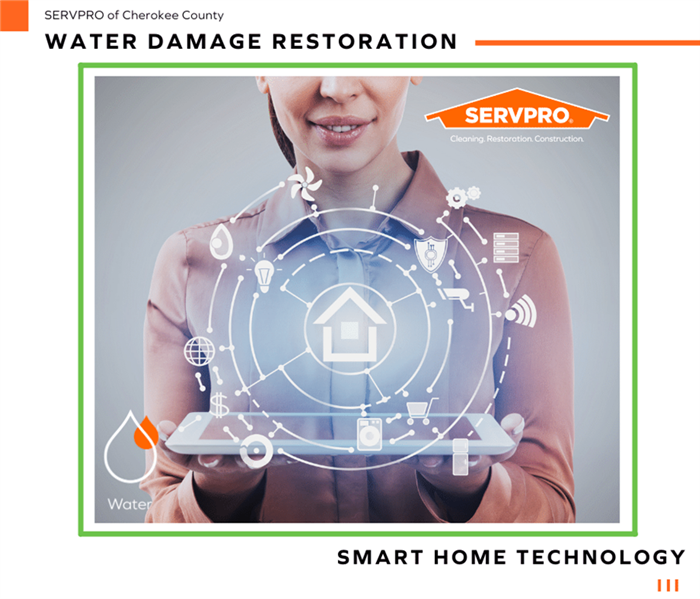 SERVPRO of Cherokee County is here to help with all of your water damage restoration needs throughout Cherokee County. Call today for rapid service!
SERVPRO of Cherokee County is here to help with all of your water damage restoration needs throughout Cherokee County. Call today for rapid service!
Smart Home Technology: Using Automation To Protect Your Home From Water Damage While On Vacation
In the modern world, smart home technology is revolutionizing how people protect their homes while on vacation. Automation provides homeowners with an unprecedented level of convenience and security when it comes to safeguarding against water damage. This article will discuss some of the ways that automation can be used to effectively prevent water damage in a residence, even during extended periods away from home.
The primary benefits of smart home technology are its scalability and flexibility; it allows for both small-scale prevention measures as well as larger investments in automated systems that monitor and manage water flow within a home’s plumbing network. Furthermore, this system can be integrated into existing infrastructure, allowing users to customize their setup according to their own needs. With these elements combined, homeowners have access to reliable protection from costly water damage caused by simple oversights or unforeseen circumstances such as power outages or system malfunctions.
Finally, this article will discuss strategies for utilizing automation to protect against potential risks associated with leaving one’s property unattended over longer spans of time. By following the tips outlined herein, readers should gain a better understanding of what steps must be taken in order to ensure comprehensive coverage against any form of water damage incurred while away from home.
The Rise Of Smart Home Technology: Enhancing Home Protection And Convenience
In recent years, the development of smart home technology has unlocked a whole new world of convenience and safety for homeowners. Smart home technology is defined as technological solutions that offer users remote access to control various aspects of their homes from any location with an internet connection. From monitoring energy consumption to controlling lighting or climate settings, this technology provides homeowners with greater peace of mind knowing they can keep tabs on their house even when away.
One area in which smart home technology can be especially beneficial is water protection and mitigation. By proactively detecting leaks and responding quickly to potential problems before they become major disasters, these systems provide significant advantages over traditional methods of prevention. In addition, automated water extraction devices like sump pumps can move large amounts of standing water out of your basement if it floods, helping avoid costly disaster recovery services such as water damage repair caused by flooding or other sources.
Smart home technologies also help protect against more subtle types of water damage prevention - things like condensation buildup around windows due to poor ventilation in the winter months, or excess moisture in areas near bathrooms and kitchens where humidity levels are often higher than normal. With integrated sensors, smart alarms and automated shutoff valves activated remotely through a smartphone app, you can rest assured that your home will remain safe from preventable water-related issues while you're away on vacation.
Water Leak Sensors: Early Detection For Preventing Costly Water Damage
Water leak sensors like Flo by Moen or the Eve Water Guard are essential components of a smart home technology system. They provide early detection and alert homeowners to the presence of water, before it can cause significant damage to their property. These devices detect even small amounts of moisture in areas where pipes, fixtures or appliances might be located, such as underneath sinks, around toilets and washing machines.
The benefits that these sensors bring are numerous:
- Early warning for potential water leaks so repairs can be made quickly;
- Protection from costly water damage restoration, flood cleanup and mold remediation services;
- Prevention of structural drying costs due to prolonged exposure to high humidity levels;
- Rapid response time to mitigate sewage backups.
By providing advanced warning on any signs of approaching flooding or other types of water related issues, smart home technology systems with water leak sensors help protect both residential properties and commercial buildings alike. As part of an automated security solution, they also allow owners to stay informed while away on vacation or business trips. Homeowners who have already experienced water damage understand how important this type of protection is when trying to minimize costly repair bills.
Smart Water Shut-Off Valves: Automatically Stopping Leaks And Minimizing Damage
The next step in preventing costly water damage while away on vacation is to install smart water shut-off valves. Smart water shut-off valves are automated devices that detect leaks and automatically turn off the main water supply, stopping it from flowing into the home and minimizing potential damage. This technology can be used alongside other sensors for additional protection, such as temperature sensors or moisture detectors. The Moen Smart Water Shutoff combined with the Flo by Moen moisture detector make for a powerful water damage prevention system.
Smart water shut-off valves can greatly reduce the risk of water damage when no one is home by shutting off the flow of water within minutes of a leak being detected. This will prevent large amounts of water from entering your house, which could lead to flooding and expensive repair costs. Additionally, many types of smart water shut-off valves also come with remote monitoring capabilities so you can monitor your system’s status even when you’re away from home.
Smart water shut-off valves are becoming increasingly popular due to their effectiveness in reducing both property damage and insurance costs associated with undetected plumbing problems. Installation is relatively easy since most units require only basic plumbing knowledge and tools to install properly. Furthermore, they provide peace of mind knowing that if anything goes wrong while you're away, your home's safety is still taken care of. With these benefits in mind, installing a smart water shut-off valve before going on vacation may prove invaluable in protecting not just your home but also your wallet from any unexpected disasters caused by unnoticed leaks.
Smart Thermostats And Humidity Control: Maintaining Ideal Conditions To Prevent Water Damage
Smart thermostats and humidity control devices are an essential part of a smart home technology system that is intended to prevent water damage while on vacation. By automating the temperature and relative humidity in your home, these devices help maintain ideal conditions needed to reduce potential sources of water damage.
A smart thermostat such as a Google Nest Smart Thermostat can be programmed to regulate the indoor temperature at precise levels based on the season or time of day, ensuring optimal comfort when you’re away. It also helps save energy by not running the heating or cooling systems unnecessarily during times when no one is present in the home. In addition, it can alert homeowners if any problems arise with their HVAC units so they can take action before significant loss occurs.
Humidity sensors detect moisture levels in the air and transmit this data back to a central hub for evaluation against predetermined thresholds set by homeowners. If high levels of moisture are detected, automated controls within the system can respond accordingly by adjusting fans or dehumidifiers to bring the environment back into balance. This prevents mildew growth from occurring due to excess dampness, which could cause costly damage over time without early intervention. Some smart humidity sensors such as the Tuya Smart Hygrometer can connect directly to your Google Home or Amazon Alexa to help you manage the humidity in your home or commercial property effectively.
By leveraging advanced technologies such as smart thermostats and humidity sensors, homeowners can rest assured knowing their homes and commercial properties will remain safe from water-related issues even when away for extended periods of time. Such automation provides peace of mind throughout vacations, allowing users to enjoy their travels free from worry about what may be going on at home.
Remote Surveillance: Monitoring Your Home For Water Damage With Smart Security Cameras
Smart security cameras are an invaluable tool for homeowners looking to monitor their homes while away on vacation. With the help of motion detectors and facial recognition technology, smart home surveillance systems can detect potential threats before they cause significant damage. By setting up these cameras in key locations around the house, such as near windows or along paths that lead to entry points, homeowners can be alerted promptly when suspicious activity has occurred. Furthermore, many modern systems like the Google Nest Cam come with night vision capabilities so that footage can still be seen during low light conditions or after dark hours.
In addition to providing real-time monitoring of one’s home from anywhere in the world, some advanced models even offer two-way audio communication with visitors at the door. This allows homeowners to respond remotely and quickly answer questions or address concerns without having to return home early from their trip. Moreover, many homeowner insurance policies will reduce premium rates for those who invest in a professional grade video surveillance system due its ability to prevent losses associated with theft and vandalism.
By utilizing automated remote surveillance systems, homeowners can enjoy peace of mind while away on vacation knowing that their properties are being watched over by powerful technologies designed to keep them safe from water damage and other unwanted intrusions. Smart security cameras provide an easy way for people to maintain control over their homes no matter where life takes them next.
Smart Sump Pumps: Keeping Your Basement Dry And Preventing Flooding
Smart sump pumps are an important part of any home automation system, especially when it comes to preventing water damage. Sump pumps are designed to pump out excess water from basements and crawl spaces in order to keep them dry and prevent flooding. With the help of a smart sump pump like the Wayne BGSP50, homeowners can easily monitor their basement’s moisture levels remotely while away on vacation.
Sensors placed in the basement or crawl space will detect any signs of increased humidity or water buildup due to leaks or floods. When this is detected, the sensor triggers the smart sump pump which activates its motor and starts pumping out the excess water into a designated area such as a nearby storm drain or yard. The homeowner will be notified via text message or email alert that there was excessive moisture detected in their basement and that their sump pump has been activated.
Homeowners who have a traditional non-smart sump pump can add technology by attaching an additional device called a “smart switch” to the existing unit so it becomes connected with other devices within the home automation system. The LevelGuard Float Switch is a great example that uses an electric field instead of mechanical parts to detect water. These smart switches allow for remote monitoring and control through smartphone apps so they can check if the sump pump is working properly and turn it off/on whenever needed even if you aren't physically at home. Smart switches also come equipped with high-water sensors allowing them to automatically activate as soon as they detect elevated levels of moisture—great for homes located near bodies of water where flooding could occur without warning.
By investing in a smart sump pump, homeowners can ensure their basements remain safe from potential water damage while away on vacation, giving them peace of mind knowing that their most valuable possessions are protected from flooding no matter how far away they may be from home.
Integrating Smart Devices: How To Create A Comprehensive Water Damage Prevention System
Smart home technology can be used to create a comprehensive water damage prevention system that can protect your home while you are away on vacation. This requires integrating various smart devices in order to provide the best protection possible and reduce the risk of water damage.
The first step is to install a sump pump, as discussed in the previous section. The next step is to integrate this with other sensors such as temperature and humidity sensors or leak detection systems. These will detect any changes in conditions inside your home and alert you if there is an issue before it develops into something more serious. Additionally, they can shut off the main water supply if needed so that further damage does not occur.
The third step is to install an app on your smartphone which allows you to monitor all of these devices remotely from anywhere in the world. Making sure that all devices integrate with a smart home device such as Google Home or Alexa will make the third step as seamless as possible. You will receive notifications about any potential issues and be able to take action immediately if necessary. With this setup, you can rest assured that your home is being monitored 24/7 for any signs of water damage while you’re away on vacation.
Backup Power Solutions: Ensuring Your Smart Home Technology Stays Functional During Power Outages
It is important to consider backup power solutions when looking into smart home technology. This can help ensure that your automation systems remain operational during a power outage, providing peace of mind and protecting against water damage while you’re away on vacation.
The most common form of backup power for smart home technology is the use of an uninterruptible power supply (UPS). These devices like the APC Back-Ups Pro 700VA provides temporary battery-based electricity in case of an outage or surge, allowing connected devices to remain powered up until normal service resumes. UPS systems are typically used with computers, but they have become increasingly popular as a way to provide reliable backup power for automated systems around the house.
A second option for ensuring your smart home system remains functional despite a loss of electrical service is by connecting it directly to an emergency generator. Generators come in different sizes and styles depending on your needs, from affordable, small models like the Sportsman 4000 Watt Generator to larger stationary units like the Generac Guardian 26,000 Watt capable of powering your whole home while offering smart connection capabilities. They are also available in both gas-powered and electric varieties, though the latter tend to cost more initially due to their higher fuel efficiency over time. Regardless of which type you choose, having a generator ensures that even if there’s a total blackout in your area, your smart property will still be able to protect against water damage while you’re away on vacation.
Backup power solutions such as UPS’s and generators offer additional protection beyond what traditional automation systems provide alone—and can prevent costly damages caused by unexpected outages or surges while you’re away from home. By investing in one or more of these options, homeowners can rest assured knowing their smart homes will stay safe no matter what happens.
Conclusion
Smart home technology is rapidly becoming an integral part of the modern home. With the use of water leak sensors, smart shut-off valves, thermostats and humidity control, remote surveillance cameras, integrated devices, backup power solutions and real-time alerts and notifications, homeowners can be confident that their homes are protected from potential water damage while on vacation. By combining these products into a comprehensive system tailored to each individual’s needs and budget, homeowners can ensure peace of mind knowing that their property is safe even when they’re away. Investing in smart home technology can provide invaluable protection against costly water damage while allowing you to enjoy your time away with ease.
However, in case water damage does occur in your business or home, our local SERVPRO of Cherokee County team is always here to help! 24/7/365, no matter when you call, we’re committed to being faster to any size disaster.
5 Types of Water Damage Testing Equipment: SERVPRO of Cherokee County
3/11/2022 (Permalink)
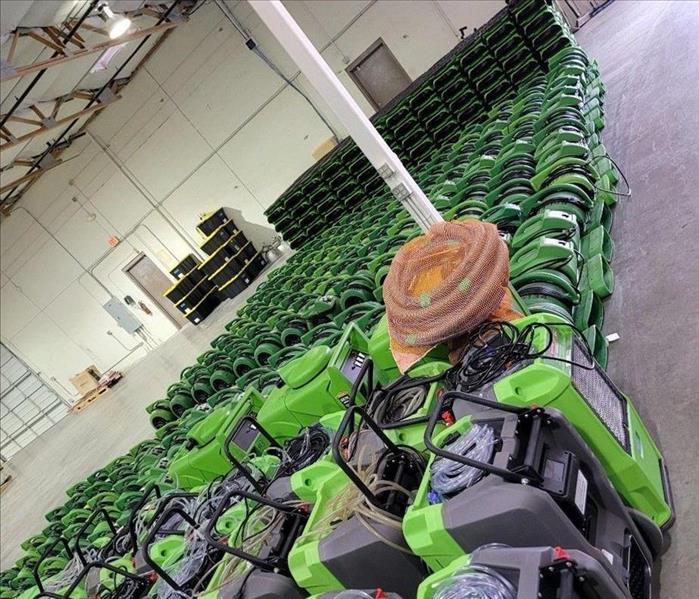 SERVPRO of Cherokee County is ready to respond to your water damage restoration call immediately when you need us. Call today!
SERVPRO of Cherokee County is ready to respond to your water damage restoration call immediately when you need us. Call today!
Because water damage can often reach areas you can't even see, our SERVPRO of Cherokee County technicians use several types of testing equipment to help you restore your property damage in Woodstock, GA and throughout Cherokee County "Like it never even happened." This equipment is used to analyze environmental conditions, test all types of building materials for potential water damage, and track the drying efficiency of the emergency water damage restoration process. Here are a few of the machines our team utilizes:
- Moisture Meters: Moisture meters are one of the most common pieces of water testing equipment. These meters such as the Dri-Eaz Protimeter SurveyMaster measure the moisture level of an environment or material and provide a digital reading on the device's screen. By using moisture meters, our technicians can quickly test whether any materials in your home are affected by water damage so they can then begin taking steps to dry them out. They are used to test everything from drywall, wood, siding, tile, insulation, carpeting, and everything in between.
- Voltage Meters: Because emergency water damage restoration equipment can require significant electrical power, voltage meters are used to ensure that the equipment is being operated safely. These meters measure the voltage of an electrical circuit and help our technicians avoid any potentially hazardous situations.
- Thermometers: In order to better understand how water damage is affecting different areas of your property, our team uses thermometers to take temperature readings both inside and outside of walls, floors, the air inside and outside of the affected areas, and more. Temperature is an important part of our local water damage restoration process because it helps our restoration technicians determine and control the speed of the water damage drying process.
- Infrared Meters: Because Infrared meters see temperature differences between different building materials, they are often used to scan for hidden water damage that might otherwise be missed. A common misconception about Infrared meters such as the Flir E6 is that they are used to see behind walls. This is not the case. However, our SERVPRO of Cherokee County technicians use them along with our other testing equipment to help demonstrate and determine the potential extent of water damage and required removal of affected materials. They can also be used to identify other existing electrical, mechanical, and building issues.
- Air Sampling Equipment: Air sampling is also an important part of the local water damage restoration process because it helps our SERVPRO of Cherokee County technicians identify and quantify any biohazards in the environment, such as mold spores, lead, pollen, insect parts, skin cell fragments, fibers, and inorganic particulates. By taking air samples inside and outside of the affected areas, our technicians and indoor air quality experts can determine whether or not specialized restoration processes are required.
SERVPRO of Cherokee County is here to help you restore your property damage "Like it never even happened." If you have any questions about our water testing equipment or the emergency water damage restoration process, please don't hesitate to give us a call at (770) 924-3848. We're always happy to help!
3 Easy Ways to Prevent Frozen Pipes
2/21/2022 (Permalink)
 Let faucets drip.
Let faucets drip.
Prevent Your Pipes From Freezing
Frozen pipes can lead to a lot of damage around the house. Not only will you be unable to get water through certain faucets, but the pipe can burst entirely, causing a flood. You need to seek out water line repair in Canton, GA as soon as you notice your water system not working the way it should. However, one option better than that is to simply prevent your pipes from freezing in the first place.
1. Keep the Heat Running
Homeowners may be hesitant to leave the heat running all day long even if people are going to be gone, but the slight increase in the power bill is well worth it to prevent frozen pipes. Bursting pipes can cause a lot of damage, especially if the water floods a room with a lot of valuables. A house does not have to be kept at a particularly high temperature. As long as a home’s interior is at least 50 degrees Fahrenheit, it should be fine.
2. Prop Open Interior Doors
If you are going to run the heat all day, you want to be certain you are getting the most out of it. Leave all the interior doors open so that heat can flow easily from one room to the next. This includes cupboards in the bathrooms and kitchen.
3. Let Faucets Drip
The main cause of frozen pipes is a buildup of pressure in the system. Homeowners in Canton, GA can relieve some of this pressure by letting faucets drip throughout the day. You should ordinarily address dripping like this as soon as you can, because it can increase water bills. Similarly to keeping the heat running, the small increase is well worth it to prevent more catastrophic damage. In the event your home does develop a burst pipe, then you’ll need to contact a professional service to repair the pipes and dry the affected room.
Think Fast About Broken Pipes
1/26/2022 (Permalink)
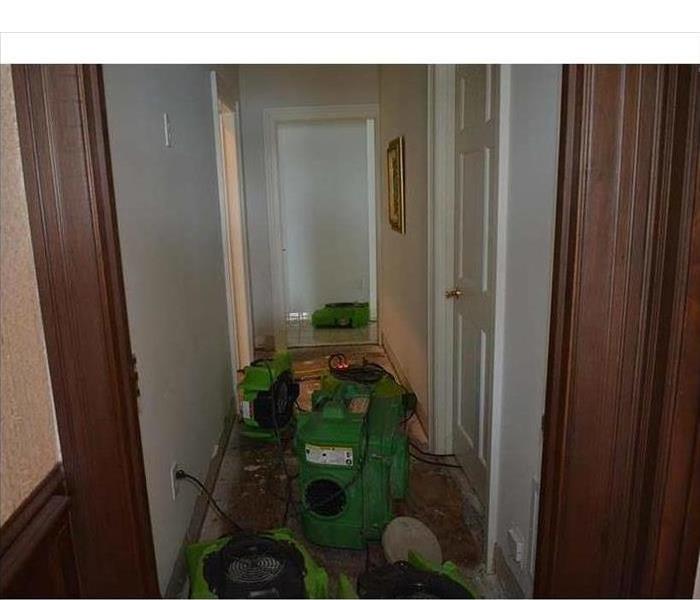 Fans and dehumidifiers will help remove water and any remaining moisture.
Fans and dehumidifiers will help remove water and any remaining moisture.
Steps To Fix a Bursting Pipe In Your Home
It always seems like an unexpected disaster happens on a day when you really don’t have time to deal with it: when you are scheduled to lead a presentation with a client, when you have to pick up the kids from school, or when you are heading out for vacation. Here are some tips so you can prepare to think fast when you have bursting pipes in your home in Oak Grove, GA.
Complications Happen Fast
The trouble with bursting pipes and other unsuspected leaks is that damage quickly goes from bad to worse:
• Wood and paper materials can be structurally damaged the longer they are left in water.
• Staining can take place when wet materials are allowed to sit against carpet or other items.
• Metal materials can start to corrode.
• Exposure to time and temperature can turn clean water into harmful “gray water”.
• Mold can start growing in about 48 hours.
Don’t delay and get started with the cleanup. Everything else can wait.
Phone a Friend for Fast Help
You may actually need to phone two friends: one to pick up your kids or do your presentation, and one professional water mitigation specialist that understands the need to act fast to fix the broken pipe and clean up water. Turn off the water so your bursting pipe doesn’t continue spraying water all over your home. It’s amazing how quickly water starts to accumulate.
The call you make to the expert will be most useful for resolving your bursting pipes quickly. The right professional will have knowledge, experience and special equipment to help you resolve the flood. Pumps, vacuums, fans and dehumidifiers will help remove water and any remaining moisture to minimize damage and prevent secondary trouble such as mold growth.
You’ve Got This
Now that you know what to expect and who to call, you can think fast during an emergency and help minimize water damage in your home.
How to Respond to a Basement Flood
12/28/2021 (Permalink)
 A basement flood in Acworth, GA, can be a catastrophic event.
A basement flood in Acworth, GA, can be a catastrophic event.
How to Handle a Basement Flood
Under normal weather conditions and with a functional sump pump, a basement flood is a rare event. However, one should still be prepared to handle such a situation should it arise, given that the speed of response can directly affect property values and environmental conditions in the home.
1. Personal Safety
In the event that it becomes necessary to enter the flooded area, a number of precautions will be necessary. If the amount of water is lower than a few inches, making temporary walkways out of cinder blocks and boards may be enough to allow you to reach pertinent areas and begin the process of removing the remaining water. However, if the situation is severe and the electric and gas systems have been compromised by water intake, it is best to have these systems disabled in order to reduce electrocution and fire risks. Standing water can also incubate disease, so boots, gloves and respirators are advised during prolonged periods in an inundated home.
2. Restoring and Reconfiguring
If the sump pump is no longer functional, restoring it should be a high priority during a basement flood, especially if further inclement weather is expected. For the same reason, any exterior factors that tend to cause water pooling around entryways to the basement may need attention, such as the direction of downspouts. Some interior elements such as wet drywall or sensitive electrical appliances may need to be replaced. Carpets, carpet padding, and subflooring may need drying or replacement depending on the type. Many insurance coverage plans may require photographic documentation of the damages in order to process claims.
A basement flood in Acworth, GA, can be a catastrophic event, but proper planning and appropriate tools can make managing the damage much easier. If the above steps are not feasible due to the risks involved, remember to contact a qualified cleanup service professional.
How To Fix a Leaky Toilet
11/29/2021 (Permalink)
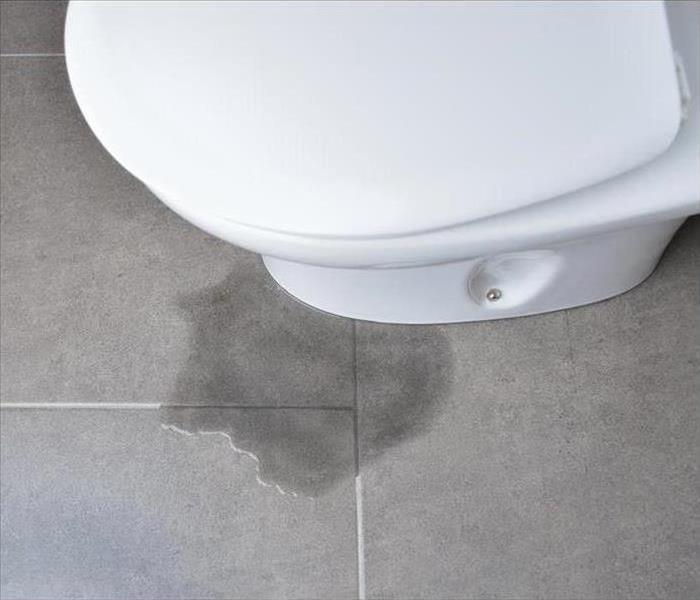 If you notice water leaking around the base of your toilet when you flush, you have a leaking toilet.
If you notice water leaking around the base of your toilet when you flush, you have a leaking toilet.
Steps To Fix A Leaking Toilet
If you notice water leaking around the base of your toilet when you flush, you have a leaking toilet. If ignored, the situation can lead to significant water damage. This type of leak is usually simple to fix by following a few steps.
There are a few causes for seeping water under the toilet base. If you have a large bathroom leak, call a water damage repair person right away.
1. Loose Connection
The easiest leak to fix is a loose connection at the base of the toilet. Shut off the water and flush while holding the handle, making sure the water has completely drained from the tank. After drying the area, remove the old washers and bolts and replace them with new parts. If you still have a leaking toilet, you may have a faulty wax gasket.
2. Faulty Wax Gasket
Once the water is shut off and the toilet and floor are dried, remove the tank lid.
Use a sponge to soak up any remaining water in the tank and wipe it completely. Loosen the nut on the shutoff valve and disconnect the tube from the water supply. Remove the caps from the closet bolts and take off the nuts.
Grab the bowl's rim at the lowest point and rock the toilet gently to break the wax seal. After the toilet has been removed, use a putty knife to scrape off any old wax on the bottom of the toilet and flooring.
Install the new wax ring on the flange and press it into place. Reconnect the closet bolts and align the toilet onto the holes in the base. Press down firmly to create a seal with the new wax ring.
Replace the washers, nuts, and caps and tighten. Finally, reconnect the water supply and turn the water on.
If these suggestions don't fix your leaking toilet in Ball Ground, GA, it is time to contact a plumber before the situation gets out of hand.
4 Plumbing Problems That Demand Immediate Attention
10/13/2021 (Permalink)
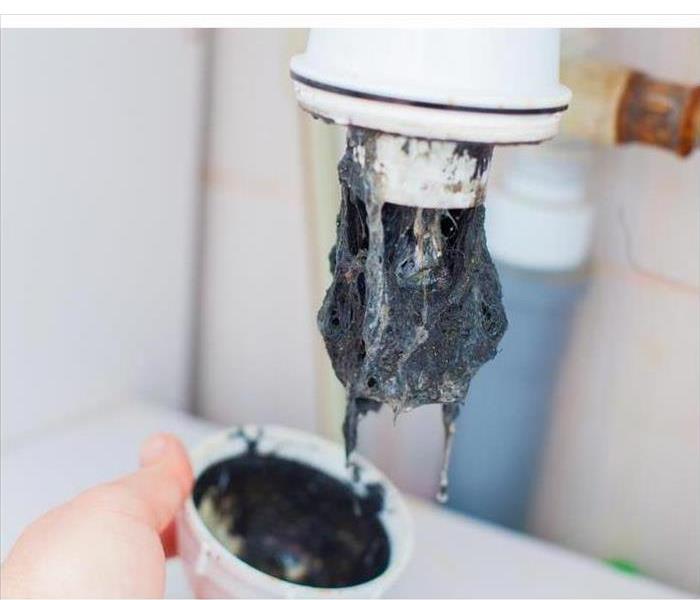 Clogged pipe in a Canton, OH home
Clogged pipe in a Canton, OH home
4 Plumbing Problems That Demand Immediate Attention
Though plumbing problems are almost always unpleasant to address, raw sewage into a home is among a homeowner's biggest nightmares. It does happen from time to time. If it does, it is smart to call in local water remediation specialists in Canton, GA. They are set up to deal with problems exactly like this, and they have the right equipment for quick and safe sewage cleaning. They are Faster to Any Size Disaster and can be of service in many tricky situations.
1. Toilet Overflow. Sometimes, a drain pipe becomes clogged between the toilet and the sewer, and when a person is taking a shower the toilet fills up with water and spills onto the flooring. This could release dirty water into the room. Sometimes the problem can be handled with drain snake or a plunger, but sometimes a plumbing contractor will be needed.
2. Clogged Pipe. A sewage line that becomes obstructed can result in contaminated water discharging back into the home. When this happens, professional sewage cleaning will be required. A category 3 water spill is the most serious level and should be professionally handled to protect human health and to prevent additional property damage.
3. Ruptured Pipe. Plumbing pipes break for any number of reasons, especially if they are old or made of outdated materials. They can also break due to freezing or to maintenance work. Whether the water is clean or dirty, it will need to removed from the home and the area dried out to limit structural damage to the home.
4. Water Heater Malfunction. At the end of its lifespan, a water heater sometimes fails, spilling 40 or more gallons of water into the home. The heater will need to be replaced and the water damage mitigated.
Professional sewage cleaning removes the dirty water from the home and disinfects all of the impacted surfaces. A quick response doesn't give the spilled water time to do additional damage to the home.
5 Steps to Saving Carpets in Flooded Rooms
6/24/2021 (Permalink)
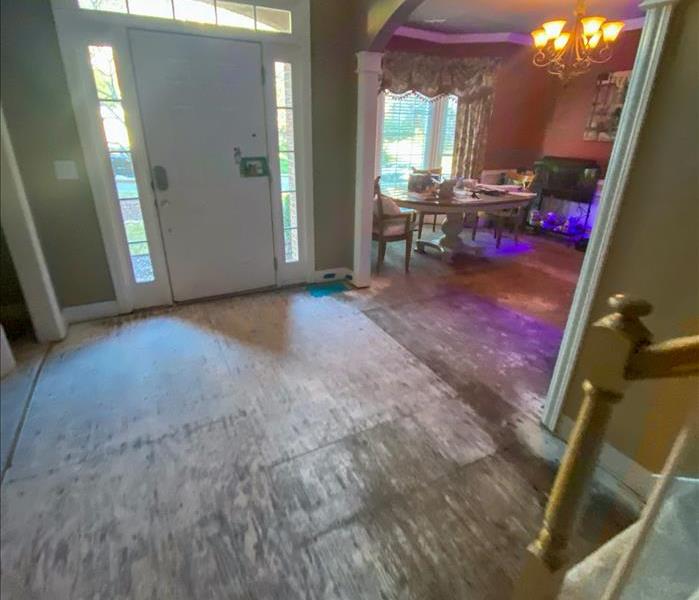 Woodstock, GA water damage.
Woodstock, GA water damage.
What To Do When You Flood Your Carpet?
Flooding due to a heavy storm or a pipe break can lead to water damage throughout your home in Woodstock, GA. A quick response from restoration experts can help you reduce the extent of the damage. One area where costs can be high is the replacement of flooring in affected areas. If you hope to keep your carpet after it has been covered by floodwater, you'll need to take the following steps:
1. Act Immediately
The severity of damage increases quickly as water is allowed to sit and remain in contact with the flooring and other building components. The longer those contents are wet, the more likely it is that mold will grow. The most effective response is to remove all water and dry the area within 48 hours.
2. Ventilate Thoroughly
Moisture on materials, such as the paper-backing of carpeting, provides an ideal environment for mold to take hold. Slow the rate of damage to hidden areas by opening the windows and installing fans. This ventilation allows you to keep air moving to dry the area more quickly and will help maintain ideal drying temperatures. One exception to this is when remediation experts install heated fans. If the technicians close the windows, don't open them until you have the go-ahead.
3. Complete Clean and Disinfect
Discuss the availability of specialized cleaning products for rugs and other floorings with a restoration expert. As you clean, protect uncontaminated areas to avoid spreading water or mold damage.
4. Assess the Damages
Do you need to replace the carpet? If the water was from a clean source, such as a pipe break or a water supply line, you'll be able to save your flooring, clothing, and other items. The best way to determine what to save is to weigh the actual replacement cost and the sentimental value of the item. However, if the floodwater contained any contaminants, you should work with a professional to determine what is safe to keep.
5. Confirm Proper Drying
Don't begin reconstruction until all wet materials have been appropriately dried. Get confirmation from your water restoration professional before covering affected wood or returning furnishings rooms with a carpet.
Tips for Restoring Items After a Flood
3/9/2021 (Permalink)
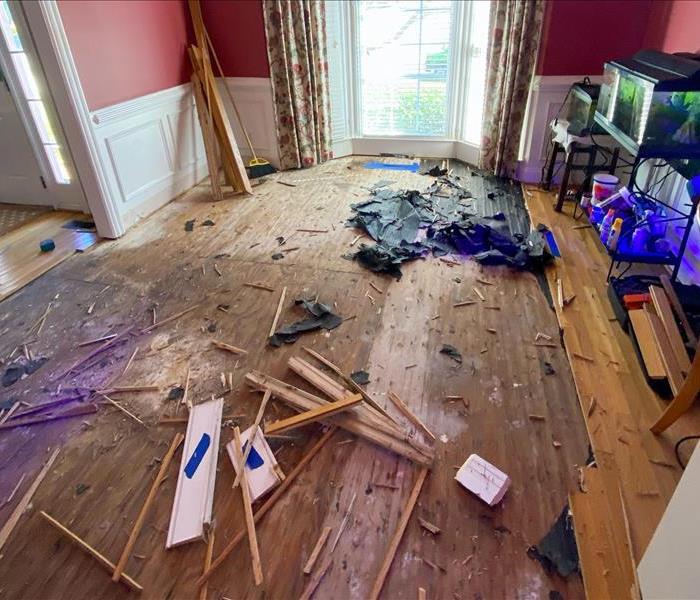 A home damaged by water damage in Free Home, GA.
A home damaged by water damage in Free Home, GA.
Tips for Restoring Items After a Flood
When your home in Free Home, GA floods, you may fear that everything is a total loss. It is disheartening enough when replaceable items are ruined, but losing priceless family heirlooms can be devastating. Fortunately, flood restoration experts can often salvage items that have damage from water in the home.
Protection
You can do your part to save your family's treasures. Start by separating damp items:
- Place in dry, open boxes or envelopes
- Remove pictures from saturated albums carefully
- Label boxes containing broken pieces of the same item
Treat your possessions gently, as water from a broken pipe makes them significantly more vulnerable to irreparable damage. Keep them out of direct sunlight, as this can cause them to fade. If you are unsure about how to handle a particular item, set it aside in a safe place and wait for the specialists to address it.
Drying
One of the first steps of the mitigation process is to remove all the water in the home. Technicians use industrial pumps to extract standing water and debris, and they discard ruined materials. You can increase air flow by turning on fans and decrease humidity with a dehumidifier. The specialists inspect each item to see if there is a way they can save it. If it can be salvaged, the structure of the piece determines the method used to do so.
Cleaning
It's possible that, in addition to getting wet, your belongings also are dirty from the flood. Specialists use the appropriate cleaning process for the material of each item. For example, most textiles can be restored with dry cleaning. Once the structure has been repaired and cleaned, you can remove all restored items back into your home.
Water in the home is not an automatic total loss. Before you throw out your beloved possessions, consult the specialists in charge of mitigating the damage. They may be able to save more than you think.
How To Prevent Clogs in Old Drain Pipes
2/11/2021 (Permalink)
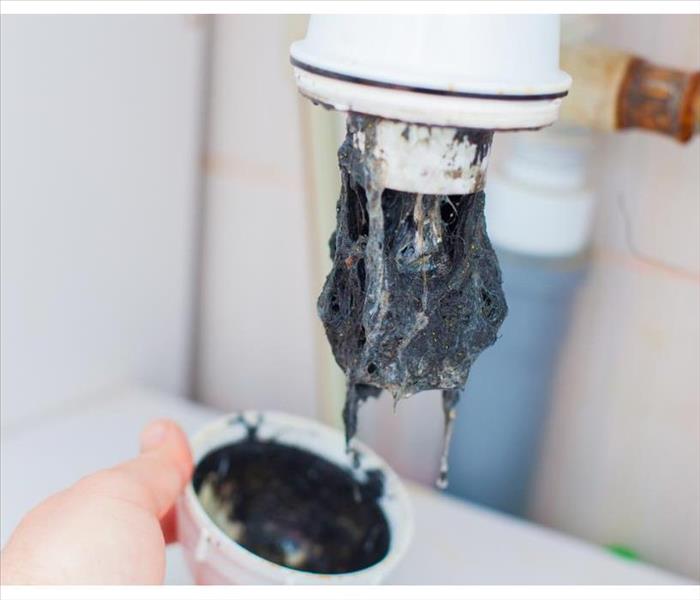 Keep your drains clear of food and hair.
Keep your drains clear of food and hair.
An old rental building in Woodstock, GA comes with plenty of charm. It may even be cheaper than an ultra-modern premise is. However, a property that was erected decades ago may also have a lot of problems. Clogged pipes, for instance, are particularly common in older structures. That is because these buildings usually feature polybutylene pipes that wear down over time.
Clogs are not just minor inconveniences, either. A major backup could cause a flood that necessitates water damage restoration services. You thus need to perform extra maintenance on your pipes to keep them functioning properly.
Enzyme Treatments
A clog can occur in a sink or in the main plumbing line. To prevent both types of blockages, follow the below steps:
1. Run Hot Water
Enzymes do their best work in warm temperatures. You should thus run the water in the sink until the temperature increases.
2. Make and Pour Enzymes
Enzymes are essentially powdered bacteria that destroy soap scum and other debris in the drain. Add water to liven up the dry enzymes and then pour them down the drain.
3. Turn on Water
Let the enzymes sit in the polybutylene pipes overnight. Then pour boiling water into the drain to flush away the remaining gunk.
Repeat this process in each sink at least once per month. You should also clear your main lines by flushing one cup of enzymes down the toilet. Do this four days in a row during each season.
Preventing Clogs
Besides using enzymes, you can also prevent clogs by keeping the pipes clear of debris. This means installing a lint catcher in any laundry room and making sure your tenants keep the drains clear of food and hair.
Tree roots are common sources of clogs, as well. You may want to chop down troublesome trees or use root killers in your toilets.
Polybutylene pipes in older properties can wear down or clog easily. Limit mainline blockages and use regular enzyme treatments to prevent severe water damage in your building.
4 Times You Need to Replace Your Carpet
12/28/2020 (Permalink)
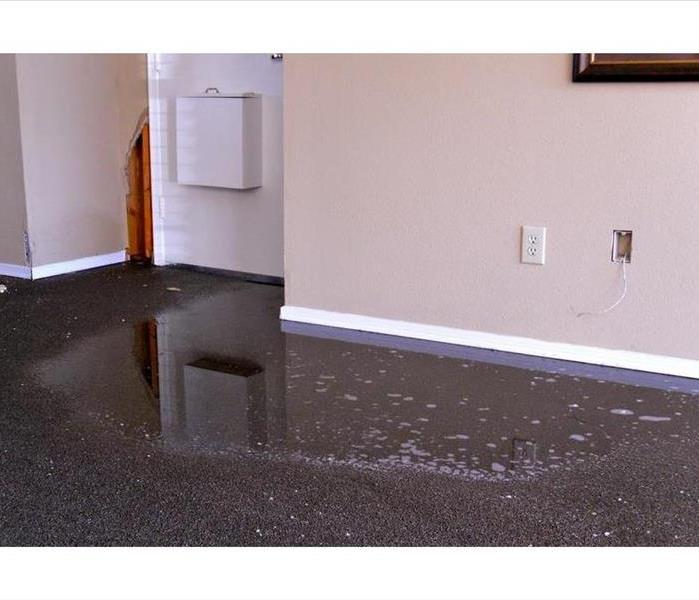 Damaged carpet floor
Damaged carpet floor
Here Are Some Times When You Need To Replace Your Rug
While regular maintenance can extend your rug's life, every carpet is going to need to be replaced sooner or later. Sometimes, it is obvious that the rug in your Woodstock, GA home needs to be replaced.
1. When It Is Stained
If a pipe break or other water damage has got you covering stains with armchairs, it is time for a new rug. Typically, the qualified remediation professionals will tell you that you need carpeting after water damage. However, if they don't or if your carpeting has other types of stains, it is time for a new rug.
2. When It Gets a Rip
That remediation after a pipe break may have led to rips in your rug. You shouldn't have to move your furniture over the rips or be embarrassed to show off your rug. If you notice tears, your rug is too far gone, and you need a new one.
3. When It Smells
If you start to notice a funny smell emanating from your floor, you should give it a good cleaning. If the smell doesn't go away, it means that it is permanent and you need a new rug.
4. When It Gets Wet
A pipe break or small water spill can cause your rug to get wet. This can lead to mold spores growing in the floor which you walk on and lay on. To keep your home healthier, you should replace a rug any time it gets wet.
Whether a restoration processed put a hole in your rug or you noticed a peculiar smell coming from your floor, it is time to get a new rug. Remember, cleaning can only get rid of some of the stains and smells. If you notice any of the signs above, it is time for a new rug.
Three Types of Contaminated Flood Water
11/23/2020 (Permalink)
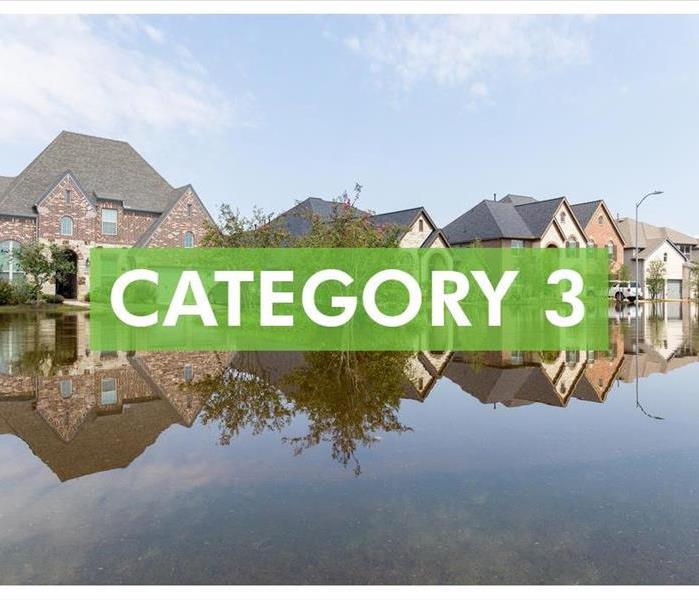 Sewage and flooding are considered Category 3
Sewage and flooding are considered Category 3
Different Types Of Contaminated Water
Water damage can wreak havoc on your Woodstock, GA home. That being said, not every home flood is the same. Flood water is categorized by the types of contaminants present. Understanding the differences among the different types of contaminated water can help you remediate the damage more effectively.
1. Clean Water Floods
Like their name implies, Category 1, or clean water floods, are categorized by an absence of contaminants. As the least dangerous types of floods, they typically originate from a supply line burst, a shower leak or some other type of clean water source. Just because these floods aren't as dangerous doesn't mean that they shouldn't still be taken seriously. A clean water flood can transform into a Category 2 flood if left untreated for too long.
2. Gray Water Floods
Gray water floods are also known as Category 2 floods. This flood contains mildly contaminated water, but nothing that could pose a biohazard risk. These floods are often caused when household appliances malfunction and flood, such as dishwashers and laundry machines. If left untreated for longer than 48 hours, a Category 2 flood will quickly become a dangerous Category 3 flood.
3. Black Water Floods
Category 3 floods, or black water floods, are the most dangerous of all. They are categorized by the presence of biohazards, such as human or animal fecal matter, raw sewage and dangerous chemicals or pesticides. You should never attempt to resolve a Category 3 flood by yourself, due to the possible health risks. Instead, you should contact water damage professionals as soon as you can. These floods are usually caused by toilet overflow, sewage back flow or a a flooding riverbank.
All types of floods are capable of inflicting serious amounts of damage. That being said, it's still important for you to learn the differences between the various types of contaminated water. Make sure to contact flood remediation experts for assistance, no matter which type of flood you're currently dealing with.
Cleaning Up Your Business After a Pipe Breaks
9/9/2020 (Permalink)
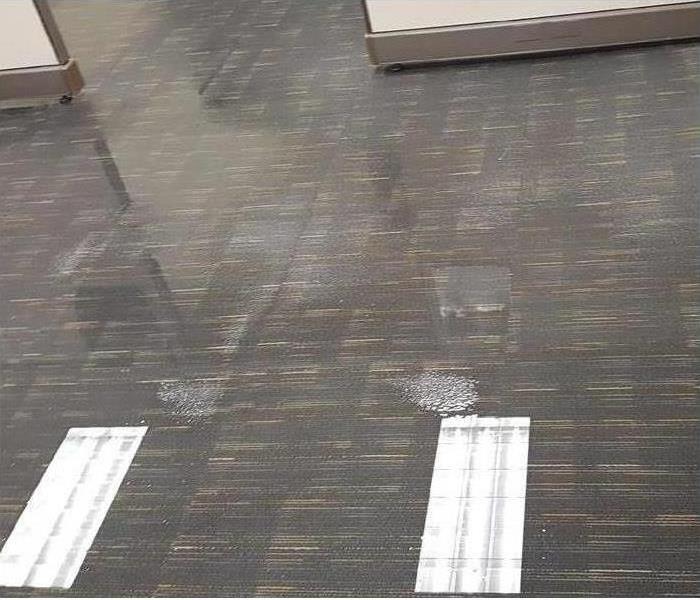 Water damage in an Oak Grove, GA office building
Water damage in an Oak Grove, GA office building
Tips On Protecting Your Business From Water Damage
When the pipes burst, your business in Oak Grove, GA, can quickly be overcome with water and subsequently sustain damage. Sometimes what starts as a small leak can expand into a major problem that requires the help of a water restoration team. There are some tips for recognizing a leak and protecting your company from water damage.
Identifying a Leak or Burst Pipe
There may be evidence of leaky or broken pipes around your business to watch out for, including:
- Wall discoloration
- A musty or mildewy smell
- Dripping sounds
- Puddles of water on the floor
Even if you notice only a small amount of water, get in contact with a water cleanup team immediately. It does not take long for a small crack to turn into a burst pipe and cause extreme water damage to your business. Noticing the signs early can help you protect your business from harm.
Acting After a Pipe Bursts
Sometimes there is no catching the problem until a major accident occurs. If you do experience a burst pipe in your office, there are several recommendations to aid in clean-up.
The water in the building should be completely turned off, and any water on the floors should be cleaned up immediately. Standing water is a breeding ground for mold, and any wet furniture should also be removed to prevent a mold infestation. Fans, mops, vacuums, and other equipment are useful for drying the space. It is important to remove all moisture from the area to prevent any long-lasting damage to your property.
Covering the Cost of Burst Pipes
In addition to having a clean-up team on standby, it is important to have a business insurance policy in place that covers water damage caused by burst pipes. By speaking with your insurance agent, you can make sure that you have the right coverage for this type of liability and that your business is thoroughly protected.




 24/7 Emergency Service
24/7 Emergency Service














